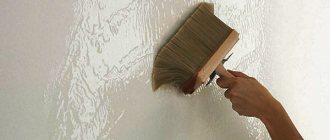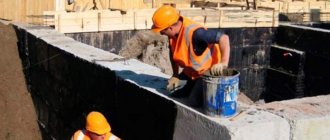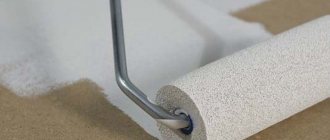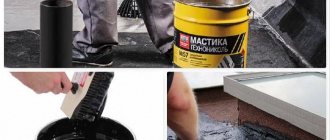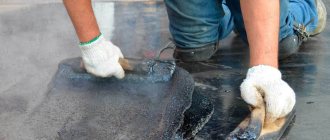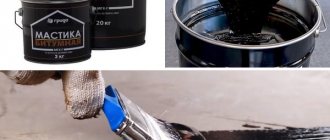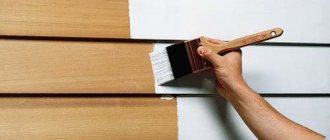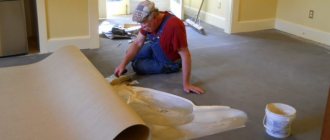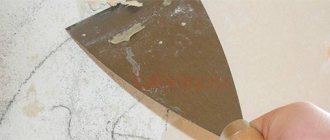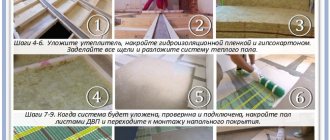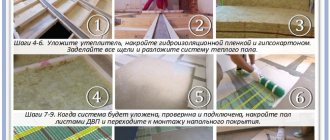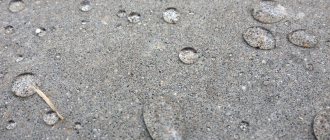Che Guevara
6646 0 2
Che Guevara December 12, 2016
The process of applying cold primer to the foundation.
The article outlines the technical characteristics and features of the use of bitumen primers. According to SNiP III-B 12-69, bitumen primer is mandatory for polymer or rubber roofing. Since the scope of primers is not limited to this, I decided to consider this material in detail.
The best face primers
To make choosing a good primer easier, we present to your attention a rating of the five most popular and in-demand products:
Librederm
. Multifunctional, domestically produced hyaluronic primer, characterized by natural ingredients and accessibility.
Despite the fact that the product has a very thick consistency, it fits perfectly on the skin, does not overload it, masks defects, hides small expression wrinkles, prevents the appearance of oily shine, and fixes makeup for the whole day. The main advantages of the product are:
- low cost;
- economical in consumption;
- lightness of texture;
- does not clog pores;
- goes well with all foundations.
Givenchy Actimine
. A product from a French brand, which is presented in six shades to perform different functions: moisturizing, whitening, masking pimples and acne, creating a tanning effect, universal use. The product is pleasant to the touch, has a “delicious” aroma, has a weightless texture, nourishes and moisturizes well. Allows you to fix your makeup for a long time.
The advantages of Givenchy Actimine are:
- the ability to select an individual shade;
- presence of an SPF filter against ultraviolet radiation;
- low consumption.
The only disadvantage is its high cost, which is inaccessible to most domestic consumers.
Holika Holika Sweet Cotton Pore Cover Base
. A Korean product consisting exclusively of natural ingredients - extracts of cotton, purslane, citrus fruits, lotus and noni. Thanks to this composition, the primer not only fixes makeup well and evens out the tone, it also fights many skin defects: reduces redness, tightens pores, and controls the production of sebaceous fat. The base applies well, does not give a feeling of heaviness, and layers well.
The product is characterized by:
- affordable cost;
- low consumption;
- lightness and lack of feeling of a film on the face;
- presence of a UV filter.
Among the disadvantages, users noted the fact that it can slightly emphasize peeling of the skin.
Clarins Eclat minute base illuminatrice de teint
. One of the best bases for dry and sensitive skin. The product combines two functions: decorative - perfectly hides and masks facial unevenness, caring - deeply nourishes, moisturizes, protects the skin. The texture of the base is very soft, light, remarkably smoothes out flaking, eliminates redness and inflammation. The advantages of the product are:
- ease of use due to the presence of a dispenser;
- multifunctionality;
- choice of three shades;
- non-comedogenic.
The downside is the high cost.
Yves Saint Laurent Touche Éclat Blur Primer
. The most popular product for oily skin.
Despite its high cost, the base has proven itself well with its natural composition and amazing effectiveness.
The product is able to tighten pores, hide imperfections, wrinkles, while giving the skin extraordinary velvety, softness, making it well-groomed and glowing.
The base has a delicate texture that carefully adapts to the skin tone.
Ready-made bituminous soils
| Name | primer TECHNONICOL No. 01 | Bitumen emulsion primer | Bituminous primer I-C-Bity Primer | PAZ PRIMER | Bitumen primer SIPLAST PRIMER |
| Description of material | A solution of petroleum bitumen (with a softening point not lower than 80°C) in organic solvents. Has high wetting and penetrating ability | The material is produced on the basis of a dispersion of bitumen in water and does not contain solvents. The primer has a neutral odor, ideal for indoor work. | Low-viscosity cold-curing bitumen mastic | Water-based liquid construction bitumen primer. Designed for joint use with materials of the “liquid rubber” class of one-component application, such as: MasterFlex, Elastopaz and Elastomix or other bitumen mastics | The primer has a short drying time, low viscosity, and provides good penetration |
| Application area | Primer of bases before laying self-adhesive, fused roofing and waterproofing materials | Priming of cement-sand, concrete and other surfaces before laying built-up, self-adhesive roofing and waterproofing materials. Provides strong adhesion of the waterproofing coating to the base | Treatment of concrete surfaces, cement-sand screeds, old bitumen carpets, etc. when installing waterproofing, roofing and carrying out repair work. It is used in all climatic regions according to SNiP 23.01. | Suitable for priming any materials: porous surfaces of concrete, foam concrete, metal, wood, as well as rolled bitumen waterproofing materials | Used as a cold primer on: — concrete bases before laying all types of roofing carpets, self-adhesive roofing carpets, bridge membranes; — steel bases before laying the membrane; - wood for waterproofing |
| Material consumption | 250-350 ml/m² (1 liter of primer is enough for 3.33 m2 of surface) | 250-350 ml/m² (1 liter of primer is enough for 3.33 m2 of surface) | 150-300 g/m2 | 1 canister with a volume of 15 l is enough to cover 50 m2. The primer can be diluted with water 1k1, in which case this initial volume is enough to treat 100 m2 of surface. | 190-240 g/m2 |
| Drying time, no more | 12 h | 1 hour | 24 hours | 1-4 h | 1.8 h |
| Package | Available in two types: — a solution completely ready for use; - concentrate - you need to add a solvent (kerosene, gasoline or white spirit) in a ratio of 1:1.5 to 1:2. Supplied in 20 liter metal buckets | metal buckets 20 kg | metal buckets 17 kg | plastic canisters of 4 kg and 15 kg. | metal containers 10 l and 30 l |
| Manufacturer | Russia | Russia | Russia | Israel | France |
.
Bitumen waterproofing mastic: types and characteristics
Bitumen roofing mastic is a special material based on bitumen and various additives. It is designed to create a waterproofing layer. Due to its composition, it is ideally compatible with bitumen roofs.
Scope of mastics:
- Creation of a high-quality waterproofing layer on concrete, reinforced concrete, wood and metal surfaces;
- Installation of flexible roofing materials (bitumen roofs);
- Sealing various roof irregularities, for example, cracks and crevices, joints adjacent to chimneys, ventilation ducts, parapets;
- Carrying out reconstruction roofing work and repairs;
- Carrying out waterproofing work when constructing artificial reservoirs and swimming pools.
One of the main advantages is the ability to carry out work without dismantling the old roofing, which is why mastic is ideal not only for installing a waterproofing layer from scratch, but also for repairs.
Why use a primer
This procedure can pursue several goals at once.
First of all, to increase the holding properties of concrete, in the language of professionals this is called increasing adhesion.
- Although concrete itself is a fairly strong material, it also requires some protection
. Moisture can penetrate into the pores and tear the surface at low temperatures. Along with moisture, chemically active substances can penetrate, which can also destroy the structure of concrete. - Another important factor is surface protection from pests
. Of course, rodents and insects are not dangerous for concrete, but mold or mildew can settle on the surface and cause serious inconvenience. - And finally, simple construction dust
. Any instruction requires that the surface be thoroughly cleaned before starting finishing work. For some facing materials this is not important. But, for example, paint cannot be applied to a dusty surface. The primer completely binds the dust particles and turns them into part of the monolith.
Top 10. Bison concentrate
Rating (2021): 4.35
- Characteristics
Average price (per 1 liter): 78 rubles.
- Country Russia
- Container volume (kg): 20
- Temperature range: -10⁰…+40⁰
- Approximate consumption per square meter (kg): 0.3
Bitumen primer is used not only during construction, but also during road work. We have just such a product in front of us, which does not prevent us from using it for roof waterproofing. The main disadvantage of the primer is its low temperature range. Already at -10 degrees, complete hardening occurs, that is, you can work only in warm weather. In addition, the product requires modification before application. This is a concentrate, that is, a full-fledged mastic. Hard and thick. To turn it into a primer, you need to add a solvent and mix thoroughly. A good solution for high product costs, but very inconvenient for private construction.
Advantages and disadvantages
- Concentrate
- Not afraid of dust and dirt
- Affordable price
- Requires addition of solvent and preparation
- Cannot work at sub-zero temperatures
Bitumen primers
Bitumen primers are ready-to-use bitumen-based primers for preparing various types of bases before waterproofing and roofing work.
Ant-Snab offers its customers bitumen primers of its own production, as well as primers from other leading Russian manufacturers.
Ready-to-use bitumen primer for preparing substrates.
Inexpensive bitumen primer for preparing surfaces during roofing work.
Classic bitumen primer for preparing bases.
Quick-drying bitumen-polymer primer for preparing substrates.
Water-based primer for preparing indoor substrates.
Let's talk in more detail about what a bitumen primer is, where it is used and why it is needed at all.
What is bitumen primer
First, a little theory:
The primer is a cold bitumen primer. The name comes from the English priming - which, by the way, is translated as “priming”.
Cold primer is called cold because it does not require any heating, preparation or any other preparation. That is, it is delivered in a form completely suitable for work. Although, there are exceptions - for example, “Primer Concentrate”, but these are quite rare cases and more often it turns out to be more convenient to use a ready-made product rather than dilute it to the desired (in your opinion) consistency.
Let's turn to Wikipedia:
“Primer is a composition applied as the first layer to a surface prepared for painting or finishing to create reliable adhesion of the top (covering layers) of the coating to the surface being treated and leveling its absorbency.”
So, we have defined the basic concepts and found out what a bitumen primer is - a cold bitumen primer. We also learned what a primer is and why it is needed in principle. Let us now move from general points to particulars.
What is bitumen primer used for?
Most often, the primer is used when installing a roofing or waterproofing carpet as a primer for the base. That is, it is used to cover a screed or other surface (for example, a foundation) before fusing bitumen roll materials.
So, why do you need to treat the surface with a primer?
Priming the screed with a primer not only ensures dust removal from the surface, but also significantly increases the adhesion of rolled materials to the base (bitumen-to-bitumen). Moreover, the bitumen primer levels the surface of the screed, penetrating into micropores and cracks that are not visible to the naked eye. Thus providing more reliable waterproofing of the base.
Improved adhesion and an additional, albeit small, layer of waterproofing created by the primer significantly increase the service life of the roofing or waterproofing pie. In addition, it reduces the likelihood of leaks.
To summarize this short but informative article, I would like to note that we in no way insist on the use of a primer when installing a roof (as opposed to the technology of work).
However, we would like to remind you that we not only produce a good and inexpensive bitumen primer, but also accompany each bucket of our primer with love and care.
We always have several types of bitumen primers in stock in our warehouse, to suit every taste and budget. And our managers will help you make the best choice based on your needs.
Call and order primers from Ant-Snab!
Calculation of primer consumption per 1 m2
The consumption of bitumen primer per 1 m2 of treated surface can vary significantly depending on several factors:
- Method of application;
- Percentage content of volatile substances in the mixture;
- Porosity of the treated surface;
- Thickness of the final layer of material.
The percentage of volatile substances that give the finished mixture fluidity is indicated on the packaging. For different types of primer, the figure varies from 30 to 70%. Using this indicator, you can calculate how much shrinkage the bituminous soil will give after drying.
Usually, among the characteristics listed on the packaging, the manufacturer himself indicates the rate of mixture consumption per square meter.
The porosity of the treated surface greatly influences the primer consumption. Obviously, for concrete, where there are small cracks and irregularities, the consumption will be greater than for metal. Average indicators for various surfaces are approximately as follows:
- metal – 200g/m2;
- concrete, screeds and plastered surfaces – 250-450 g/m2;
- wood – 300-350 g/m2.
When applying bituminous primer using the bulk method, as well as when repairing old soft roofs with a highly rough coating, the consumption can increase to 500-750 g/m2.
Types of primers
Primer is the most important part of preparing any surface for further finishing; it affects the tenacity of the base with subsequent materials.
The role of a primer in waterproofing is played by a bitumen primer; it is mainly used to treat foundations, building walls, flat roofs, various underground and above-ground structures, including bridges and pipelines.
It can be used on surfaces such as concrete, metal, wood, asbestos cement, reinforced concrete, etc.
To treat the foundation, one of the following three types of primer is most often used:
- Original - based on bitumen and solvent;
- Emulsion - water based;
- Bitumen-polymer primer.
Let's look at each foundation waterproofing primer individually.
Bituminous
Under the foundation mastic, which performs a waterproofing function, a bitumen primer is most often applied according to the classic recipe - bitumen mixed with a solvent, which can be gasoline, white spirit or toluene.
You can purchase a bitumen-based primer in one of two types:
- Completely ready for application;
- Concentrated solution.
Before starting work, you must dilute the concentrate yourself with a solvent according to the instructions. Usually the solution is diluted in the following ratio - 1 part primer / 1.5 or 2 parts solvent.
It is best to work with bitumen primer indoors with good ventilation or outdoors, as it contains solvents with strong unpleasant odors that can cause ill health and dizziness.
Among the advantages of this material, the following characteristics are worth noting:
- Heat resistance – up to +80 degrees (allows use for roof treatment);
- Ability to work in the cold season;
- Anti-corrosion properties;
- Increased adhesive characteristics;
- High drying speed;
- Water resistance.
Emulsion
An emulsion primer is an aqueous emulsion of petroleum bitumen, modified with various additives that improve the waterproofing properties of the solution.
It is used most often when carrying out interior work - processing walls, floors, ceilings. It does an excellent job of protecting concrete and cement-sand substrates from moisture and significantly increases the tenacity of the surface:
The composition of the emulsion solution is completely safe; it does not contain solvents or other toxic substances that can emit dangerous fumes.
Polymeric
A primer containing polymers is used when working with various substrates - concrete, metal, wood, brick, etc.
It is produced only in a ready-to-use form and can be used for external waterproofing in all weather conditions, including sub-zero temperatures.
This type of primer requires no more than five minutes to dry, which can significantly save time and reduce the time required for repair work.
Content
Depending on the base, polyurethane, epoxy, and bitumen primers are distinguished. When choosing, they are guided by the properties of the base material. The peculiarity of bitumen compositions is the successful combination of high-quality bitumens with solvents, thanks to which the primers acquire the ability to penetrate deeply into the structure of porous surfaces, stick waterproofing materials to them, and dry quickly. Primers are used to prevent dust formation.
Depending on the scope of application, there are several types of primers:
- Roofing. This construction chemical is successfully used to prepare the surfaces of roofing structures before starting waterproofing work. The compositions level the base well and firmly glue roll and sheet materials.
- Road. To strengthen the base of the road surface, special road primers are used. They glue bulk materials together and prevent premature destruction of structures.
- Insulating for pipelines. When arranging pipeline protection, various covering materials are used. They are attached using primers. By firmly connecting to the treated surface, the compounds form an additional protective layer, which increases the resistance of metals to corrosion.
- Universal. Compositions of this type are suitable for priming any surfaces. Universal primers include TechnoNikol 1. It is used for waterproofing various types of structures, often used when installing flat roofs.
Not together, but instead: we use glue
Sometimes glue is used to strengthen walls. Not any, of course, but only PVA. It contains chalk and plaster and is convenient if the wall is covered with wallpaper. Sometimes PVA is used instead of a real primer to save money, but will such a penny save a ruble?
Experienced repairmen say that replacing the primer with glue is not the best and most correct solution. The fact is that over time (after 2-3 years) the adhesive coating begins to turn yellow. Yellowness appears even through dark wallpaper with a bright pattern! In addition, PVA will not protect the wall from mold and insects.
PVA glue is not a primer at all; you should choose such a product only as a last resort, if other options are impossible
And you won’t be able to save much: a difference of 5-10 rubles per liter will not be too significant in this case.
Choosing the right primer for ease of application
Before you start figuring out how to use a facial primer, you should pay special attention to choosing the right cosmetic product, since a lot really depends on it. The cosmetics industry today is ready to please all beauties without exception with an extremely wide range of new products, among which you will have to choose exactly what you need
Only by setting your priorities correctly will you end up with gorgeous makeup, and we’ll tell you how to apply primer a little later.
Important
Many girls mistakenly believe that their facial skin will definitely acquire the shade that the chosen primer has, so they refuse greenish, orange or pink-lilac shades. This is not correct, since the product has a translucent, weightless texture that lays down in the thinnest layer and does not give an overall shade, but rather works by reflecting light waves at a certain angle.
Mattifying primers
Mattifying primers are specially created to be used in the summer heat, when people sweat greatly. Having treated your face in the morning, say, getting ready for work, you can be completely sure that the makeup will remain exactly the same as it was, and will not smear or float. This mattifying primer is suitable even for excessively oily and sensitive skin with signs of acne.
Corrective multi-colored products
Corrective primer is a unique product that will help disguise small scars, cicatrices, acne marks and other minor imperfections in the dermis. Such primers, unlike matting ones, which come in exclusively beige tones, can be greenish, pink, orange, lilac and yellow. They act not only as a concealer, but also as a corrector, working by refracting the sun's rays.
Moisturizing, caring and toning primer
When starting to figure out how to use a primer, you should not forget that this cosmetic product can not only hide and mask the imperfections of the dermis, but also care for it, moisturize and nourish it. Any of the above-described products may well have similar qualities and properties, so it is worth devoting enough time to choosing and familiarizing yourself with the assortment. This product is perfect for mature and aging skin; it will effectively hide wrinkles and blemishes. There are also tinted and sparkling foundations, which are also in particular demand, especially among glamorous girls who often visit clubs, restaurants, social events and other similar establishments and events.
Eye primer
In addition, there is also a primer specifically for the eyelids, which will help to fix decorative cosmetics for a long time. It ensures that the shadows remain as bright as immediately after application throughout the day, even in the most intense heat. At the same time, such a product nourishes and moisturizes thin and sensitive skin above and under the eyes. However, here you need to be extremely careful and first figure out how to apply the primer correctly in order to achieve exactly the effect that is expected.
Top 6. ECOMAST
Rating (2021): 4.59
The most reliable protection Primer with a unique set of additives that provides better insulation and protection not only from moisture penetration, but also from the formation of fungus and mold.
- Characteristics
Average price (per 1 liter): 918 rub.
- Country Russia
- Container volume (kg): 5
- Temperature range: -30⁰…+50⁰
- Approximate consumption per square meter (kg): 0.2
If you are not used to half measures and you need the best bitumen primer, then ECOMAST is exactly what you need. Its main drawback is the price. The product is very expensive, but this price tag is fully justified by the composition. It includes more than 20 different additives. Including a set of solvents, both natural and chemical, as well as plasticizers and bactericidal components. This mastic will reliably protect your home from any adversity. She is not afraid of mold and corrosion. It can withstand even large amounts of water and interacts with any surface. In addition, consumption is only 200 grams per square meter, which partially offsets the not-so-attractive price tag.
Advantages and disadvantages
- Economical consumption
- Unique composition
- Maximum protection
- Highest ductility
- Very high price
- There are fakes
Material Information
Bitumen primer is a black liquid that should not contain foreign inclusions. The composition contains no impurities harmful to human health, since petroleum bitumen dissolves in an organic composition.
- If the store sells ready-made soil, it should be mixed with a construction mixer before use.
- When purchasing a concentrate, you will have to prepare it for use; for this you will have to buy a special solvent, the class of which will be indicated on the packaging. It is worth noting that a concentrated primer is much more profitable than a ready-made one - it is more economical. It should be diluted strictly adhering to the proportions specified by the manufacturer.
- The primer has a specific odor, so it must be used in a well-ventilated area or outdoors.
- The primer increases adhesion and can be used for all types of surfaces: metal, wood, reinforced concrete, concrete, asbestos-cement, and various types of porous materials. Before waterproofing an underground structure or roof, the surface of communications or the foundations of buildings, you need to apply bitumen primer.
- The primer has an anti-corrosion effect, so using a primer on metal surfaces protects pipes from rotting and increases their service life.
- The primer can be used at any time of the year, even in hot weather, since its softening process begins at 80 degrees.
What to consider when purchasing a primer
When choosing a primer at the market or in a store, it is important to consider the following points:
- What kind of coating will be applied after priming? For example, if a rubber or polymer coating is subsequently applied, then you need to purchase a rubber or polymer type of primer.
- Technical characteristics of the primer, such as how elastic it is, how durable the product is, how long it takes to dry, and whether it contains additives.
- For what types of substrates is the product used? The instructions should indicate which surfaces the emulsion can be applied to; it can be concrete, wood; in addition, universal primers are produced for all types of surfaces.
- Is there a quality certificate for the primer?
- What is the material consumption per 1 m2.
Primer types
There are several types of this product, the cheapest is simple primer. Bitumen-polymer material is much more expensive; it contains special substances that promote rapid drying, while at the same time isolating the surface much better from the effects of nature. Primer, bitumen emulsion – used for interior work, diluted with water.
Application and positive aspects of bitumen-based soil
Bitumen primer is similar in properties to plaster, and is intended to protect porous materials, only, unlike gypsum mixtures, it can be used for metal surfaces and in roofing work.
Impregnation of the base with bituminous soil is intended as a starting coating before using various waterproofing materials.
Due to its dense composition, the primer clogs all the pores of the material, making it resistant to moisture. Waterproofing of various structures using a bitumen primer becomes better.
Let's consider in which areas it is most preferable to use bitumen primer.
Scope of application
Primer is a primer designed to fill the pores of the material, level out small roughnesses and irregularities, and remove dust from the material. It is used for primary treatment and improving the adhesion of the waterproofing material to the base.
The material can also be used as independent surface insulation, in cases where the base is not constantly exposed to moisture.
Many builders use emulsion primers to coat surfaces in the bathroom and kitchen, where air humidity is high.
Now there are many types of this material on the market, which are used:
- for roof treatment;
- floor coverings;
- basements;
- foundations;
- sewer pipes and water supply systems.
The performance characteristics of each type of bitumen primer differ from each other, and you only need to use the material that is suitable for a particular type of surface.
Characteristics of bitumen impregnation:
Types of bitumen primers
Manufacturers of this type of primer for waterproofing produce a wide range of materials with different properties, for example, different brands of product:
- Primer intended for deep impregnation of concrete surfaces, foundation blocks, self-leveling floor coverings, sand-cement plasters.
- For insulating wooden decks or walls.
- Material for processing pipes and metal spans when waterproofing work is planned.
- Emulsion primer that can be applied to a damp surface indoors.
All impregnations can be applied with a brush or roller. Before treatment, the surface should be thoroughly treated - cleaned of old coating and degreased.
Universal formulations
In addition to specialized formulations, manufacturers produce universal acrylic-based materials that can be diluted with water.
A universal bitumen primer primer, used in residential premises, while its composition contains antiseptic additives and has antifungal properties.
This material can be applied to any surface:
- brick;
- aerated concrete;
- plaster;
- concrete;
- Fiberboard;
- drywall;
- chipboard;
- DSP.
Universal foundation primers are used for exterior work, when it is planned to apply decorative plaster to the base plaster layer. The material is vapor permeable, while protecting the surface from adverse weather conditions.
Universal bitumen soil has the following advantages:
- high adhesion of the base and material;
- allows air to pass through;
- makes the base waterproof.
Terms of use
Surface humidity should not exceed 15%.
The primer is applied in any weather; the restriction for use is surface humidity of more than 15%. It is difficult to apply the solution to vertical walls and other planes, because it flows.
Processing Tips:
- After application, apply polyethylene film to vertical surfaces. The material adheres to the surface and holds the composition until completely dry. Then the covering is removed.
- If the primer is used to glue layers of material, wait for the first layer to dry for 4 - 5 hours, then apply a layer of glue.
To increase the adhesion of materials, they are rolled over the surface with a roller.
How to calculate consumption
The indicator depends on the type of impregnation and the porosity of the surface being treated . Manufacturers indicate consumption data on the label.
Standard consumption for frequently insulated surfaces (per 1 square meter):
- metal - about 200 g of product is spent on one layer;
- slate, asbestos cement, cement-sand plaster, concrete - 250 - 300 g;
- dense wood - 300 - 350 g;
- old roofing made of rolled material - 500 g.
Valera
The voice of the construction guru
Ask a Question
If the old roof had roofing felt with fine-grained topping, up to 1 kg of soil will be needed per square. They reduce consumption by thoroughly cleaning the surface of the roof or wall from dust and dirt. The layer of debris absorbs the product, so the penetration depth decreases and consumption increases.
Preparation for use
The integrity and effectiveness of subsequent layers depends on the quality of the first priming. The surface is cleared of debris and moisture is removed during the rainy season . A bitumen-based primer will harden and adhere to a wet roof, but it is better if there is less free moisture. Cleaning concerns snow and ice.
Preparing the composition for work:
- in frosty weather, the primer is heated in a room where the air temperature is not lower than +15°C;
- before use the concentrate is diluted , the finished solution is mixed throughout the entire volume;
- For thickened compositions, use white spirit and a small amount of solvent.
After opening the container, the material can be used for some time. Information about this is on the packaging. Store it in a container with a tight lid at a temperature of +30 - +50°C, away from fireplaces, stoves and heating units.
Application technology
The product is applied using various tools. It is necessary to ensure uniformity so that the composition saturates all areas without gaps.
Devices used :
- long-handled brushes
- voluminous fur rollers with an attachment.
The first method is to soak a brush or roller in the solution and roll it out flat. In another case, the solution is poured from the container onto the surface in small portions at a certain distance. After this, the product is leveled with a tool until the entire area is completely covered.
The soil is used to impregnate the surface of the roof where glass insulation or other roofing material will be laid. Primer is not applied to the fiberglass strips themselves.
Safety precautions
Fire extinguishing agents must be available at a construction site.
Bitumen is classified as a substance with an increased risk of ignition. Materials that are laid using the fused method (with a burner) begin to be installed after the solution has completely dried.
Safety regulations:
- Fire extinguishers, shovels, and hooks are placed at the site so as to quickly respond to fire;
- For heating, serviceable fireboxes made of non-combustible materials are used;
- move bitumen in tightly closed containers at a distance of no more than 50 m;
- Open openings indoors, wearing a respirator and gloves.
Smoking is prohibited on the work site. In case of contact with skin, wipe off the mixture with a rag, wash with soap and water, in case of contact with eyes, rinse with plenty of water, call an ambulance.
How to remove primer
If the contamination happened recently and the soil has not hardened, you can do without chemicals. You need to remove the substance with a scraper, then wash with soapy water. You can use white spirit solvent or gasoline.
On metal surfaces, use special store-bought products to remove bitumen. The drugs are sold in bottles or in the form of sprays, they do not leave any traces.
Features of the use of primers
The most universal and popular primers used in wall treatment are deep-penetrating primers. They impregnate the walls before painting, puttying, wallpapering or laying tiles. They perfectly remove dust from the surface and reduce its porosity, preventing excessive absorption of moisture from the applied adhesive solution or paint coating. The most popular and well-known representative of this class of primers is Ceresit ST17.
If the cement screed has dried out and cracked, then treatment with a strengthening primer such as Mapei Prosfas will strengthen it and eliminate cracks. The liquid primer penetrates deeply into the pores and cracks of the cement base and, when dry, tightens and binds the scattered parts of the surface. By impregnating the top layer of the screed with an adhesive to a depth of several centimeters, the primer helps to enhance its strength and load-bearing capacity.
Hydrophobic impregnations are used to treat the surfaces of stone and brick structures and to grout the joints of tile slabs to give them water-repellent qualities. After applying a water-repellent primer, stone or brickwork acquires a completely waterproof surface; it will not absorb moisture and form noticeable dark damp spots.
Video: Maximum penetration of primer into the base
If you are going to finish a wall with a glossy surface, then adhesive primers like Knauf Betonokontakt are best suited for forming an adhesion layer. Such primers contain quartz sand, which gives the wall surface, after the mixture dries, the ideal roughness necessary for strong adhesion to the adhesive solution and finishing material. With their help, you can lay new tiles on old tiles without dismantling.
In cases where the walls to be finished will be used in conditions of high humidity, for example, baths, swimming pools, laundries, etc., before finishing they should be treated with an antifungal primer, which will provide them with resistance to the formation of mold and fungi, significantly extending the period between repairs services. The composition of these primers is universal, providing the treated surface, in addition to bacterial protection, with waterproofing and increased adhesive properties.
DIY making
There are low-quality products on the construction market that are produced with deviations from technology. As a result, the primer takes a long time to dry or does not set at all. The surface remains damp and is not suitable for gluing the following materials.
The process of making bitumen primer yourself:
- prepare unleaded gasoline (1 kg);
- bitumen is melted in a container with a blowtorch or on a stove until it turns into a liquid state;
- cool the melt to a temperature of +80°C;
- melted resin is mixed into a container with gasoline in small portions (if added immediately, the gasoline will ignite);
- the resulting mixture is passed through a metal sieve.
Unleaded gasoline does not contain lead additives, which ensures its environmental friendliness. In Russia, gas stations sell only these types.
Why is it necessary to prime
The strength and durability of any structure directly depends on the foundation, so it is important to take a responsible approach to its preservation from the harmful influence of the external environment. As a rule, the foundation is built from concrete, which, despite all the advantages, has one important disadvantage - poor resistance to moisture
To increase its water resistance, various waterproofing materials are used - polymer mastics, deep penetration impregnations, bitumen coatings and mastics, roofing felt and other roll insulation
As a rule, the foundation is built from concrete, which, despite all its advantages, has one important disadvantage - poor resistance to moisture. To increase its water resistance, various waterproofing materials are used - polymer mastics, deep penetration impregnations, bitumen coatings and mastics, roofing felt and other roll insulation.
Most often, builders use bitumen mastics and mortars, since they are quite easy to work with and are available in ready-made form. But then, when the question arises about whether bitumen mastic or a primer is better for waterproofing a foundation, the correct answer is to use these two products together.
The primer acts as a primer to prepare the base before applying waterproofing. Priming is primarily necessary for the following purposes:
- Increasing surface adhesion with subsequent finishing;
- Saving of the main waterproofing material (due to the fact that the base is impregnated with a low-concentrated mastic solution);
- Surface strengthening;
- Reduced time for further processing.
Suitable bitumen primer for most surfaces:
- Tree;
- Plaster;
- Concrete;
- Gas and foam ben;
- Drywall;
- Brick;
- Metal.
The main advantages of bitumen primer are as follows:
- Maintaining surface vapor permeability;
- Increased water resistance;
- Increased tenacity followed by finishing.
Bitumen mastic is a common material for protecting any surface from water - from the foundation to the roof of a building; it is also used to seal cracks and gaps that have arisen. Waterproofing mastic for foundations is divided into four types:
- Bitumen - consists of only two ingredients - solvent and pure bitumen;
- Bitumen-rubber – crumbled rubber is added to the original recipe;
- Bitumen-polymer - plasticizers and various artificial substances are mixed in, which improve the properties of the material;
- Polymer - consists entirely of polymers, there is no bitumen.
How long does it take to dry?
The drying time of the bitumen primer layer directly depends on the ambient temperature: the colder it is, the longer the composition will harden. The hardening period declared by the manufacturer is 12 hours . The material is considered dry when the surface stops sticking to your hands.
The operating temperature range of the material varies from -10...+40 degrees . If work is carried out at temperatures below +5 degrees , the composition for at least 24 hours .
How to choose and use roofing primer correctly?
Installing a soft roof is a rather complex, labor-intensive technology in which everything is important, from preparing the base of the roof to laying the finishing coating itself. Experienced craftsmen claim that the service life, reliability and strength of the roof largely depend on the preparatory stage of work.
Primer for roofing made from roll materials is used to prepare the base and facilitate the installation of roofing material; not all craftsmen know about its correct use. In this article we will tell you what priming of the roof base is, as well as what compositions and at what consumption are used for this operation.
Why prime the surface for waterproofing?
Separation of the waterproofing layer and depressurization of the roof often occur due to the difference between the coefficients of thermal expansion of the base and the deposited roll material. Under significant wind loads, a waterproofing carpet laid directly on concrete or metal without the use of a bitumen primer comes off the base.
Bitumen primer prevents such situations, preventing depressurization of the roof. When using IKOPAL products for priming surfaces, the adhesion force between the roofing covering and the metal or concrete base is so great that depressurization does not occur even with constant sudden changes in temperature or strong gusts of wind. The negative consequences of this cannot be described.
Bitumen primer in construction ↑
What is bitumen primer? This is a mixture of high-quality petroleum bitumen, which has a fairly high melting point (about +80°C), and specially selected organic solvents or water. The composition has high penetrating power and dries quickly. It is used for priming various surfaces, giving them hydrophobic properties.
The range of primers and mastics is very wide
In construction, a primer solves several problems at once:
- Provides the required level of adhesion of roofing materials (up to 0.5 MPa), which is one of the mandatory requirements for installing bitumen waterproofing.
- Additionally strengthens the base by binding small volatile particles and filling small cracks.
- Accelerates the process of melting finishing materials and moisturizes the surface.
The use of a bitumen primer is mandatory when installing waterproofing:
- foundations;
- interfloor ceilings;
- underground structures in contact with the ground;
- bridge spans;
- flat roof;
- surfaces of metal pipelines;
- basements.
Bituminous primer does not impose any special requirements on temperature conditions (the range is from -50°C to +120°C), covers the surface in one layer and dries quite quickly.
Fast-drying primer requires speed in application
Traditionally, there are two types of primer: the ready-made one can be used immediately (you just need to stir it well first), and the concentrated one will have to be diluted to the desired consistency.
The classification by area of application is more clear:
- Roofing. It is used to smooth out imperfections in porous surfaces before installing waterproofing materials, and also as an adhesive for sheet and roll roofing.
- Road. Acts as a binder when laying the road surface (filling crushed stone).
- For pipelines. It has high adhesion and anti-corrosion properties.
- Universal. Suitable for all surfaces. The exception is cases where a composition with specialized additives is required.
The most commonly found waterproofing primer on the domestic market is the TechnoNIKOL brand. We will consider the characteristics of this product as an example.
| Primer No. 1 ready | Primer No. 1 concentrate | Primer No. 3 polymer | Primer No. 4 emulsion | |
| Short description | Classic primer for preparing substrates for laying self-adhesive and weld-on materials | Suitable for metal and concrete bridge structures, roofing work | Water-based bitumen primer for internal waterproofing work | |
| Consumption | 1 liter per 3.33 m2 | |||
| Packaging, liters | 10, 20 | 20, requires dilution in the ratio 1:1 – 1:1.5 | 20 | 20 |
| Drying time | 12 hours | Quick dry, 10 minutes | No more than an hour | |
| Percentage of volatiles | 45-55 | 35-40 | 25-30 | 25-40 |
| Conditional viscosity, seconds | 15-40 | 10-30 | 5-30 | |
| Softening temperature, C | 70 | 75 |
It is better not to purchase bitumen primers without a label.
Top 8. BITUMEN PRODUCT BP-001
Rating (2021): 4.47
Best price The cheapest bitumen primer, costing almost twice as much as its closest competitor.
- Characteristics
Average price (per 1 liter): 65 rubles.
- Country Russia
- Container volume (kg): 15
- Temperature range: -20⁰…+40⁰
- Approximate consumption per square meter (kg): 0.4
The company is famous for its extensive catalog. It has both expensive, high-quality products and budget ones. This is the cheapest primer, but its quality characteristics cannot be called bad. Mastic has high adhesion. Quickly penetrates the surface of the material. It has bactericidal protection and good plasticity. The best option for those who want to save money. But you have to put up with a long drying time. About three hours from the moment of application. And also with heterogeneity of structure. Before use, the primer must be thoroughly mixed and this procedure must be repeated approximately once an hour.
Advantages and disadvantages
- Attractive price tag
- Optimal characteristics
- Trusted manufacturer
- High consumption
- Heterogeneous composition and consistency
Methods for preparing mastic before work
All compositions for priming the roof base before laying rolled waterproofing and roofing materials are divided into hot-cooked and cold-cooked materials. The preparatory stage that the mastic goes through before application to achieve maximum results depends on this:
Cold preparations must be thoroughly mixed before use to obtain a homogeneous mass without sediment. For this, it is better to use a construction mixer, since the liquid can be quite thick, and it takes a long time to mix. In addition, if priming with a primer is carried out in freezing temperatures, it is better to warm it up to at least room temperature for easier application. Before use, hot preparations must be melted in a water bath at a temperature of 200C to 300C
It is important not to overboil the mastic, otherwise it will begin to smell unpleasant and will be spoiled. It is recommended to heat the composition in a special container, closed with a lid, avoiding open flame and stirring constantly.
Please note that you can be sure of the quality of the composition only if you choose products from trusted manufacturers. The leader among companies producing waterproofing building materials is Technikol. The characteristics of their primers allow the compositions to be used in any weather conditions and for completely different substrates.
